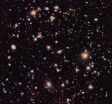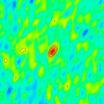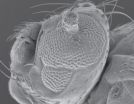(Press-News.org) Astronomers using the NASA/ESA Hubble Space Telescope have uncovered seven primitive galaxies from a distant population that formed more than 13 billion years ago. In the process, their observations have put forward a candidate for the record for the most distant galaxy found to date (at redshift 11.9), and have shed new light on the earliest years of cosmic history. The galaxies are seen as they were when the Universe was less than 4 percent of its present age.
A team of scientists using the Hubble Space Telescope has made new observations of the Hubble Ultra Deep Field (see [heic0406][1], [heic0916][2]), as part of a project to improve our understanding of the early years of the Universe.
The resulting images offer the deepest ever view of the Universe at near-infrared wavelengths, which capture the redshifted [1] light of early galaxies. Because light takes so long to travel from these remote objects, astronomers are looking back in time, seeing these galaxies as they appeared 600 million years after the Big Bang (the Universe is now 13.7 billion years old). One object spotted by the team may be the most distant ever observed.
The new data have allowed the team, co-led by Richard Ellis (Caltech, USA) and Ross McLure (University of Edinburgh, UK), to uncover six previously-unknown galaxies in this era, and to rule out a number of tentative identifications of distant galaxies made by other scientists in previous research. This is the first statistically robust census of galaxies at such an early time in cosmic history, and shows that the number of galaxies steadily increased with time, supporting the idea that the first galaxies didn't form in a sudden burst but gradually assembled their stars.
One previously-claimed candidate extreme redshift galaxy in the Hubble Ultra Deep Field was confirmed by the team. This is UDFj-39546284, for a while claimed to be the most distant known galaxy, at redshift 10 ([heic1103][3]). However, the improved and extended dataset has allowed the scientists to shed unexpected new light on this object, showing that it either lies at an even greater distance than previously thought (at a redshift of 11.9, handing it back the distance record), or must otherwise be a previously unknown type of extreme emission-line galaxy at much lower redshift [2].
"Our study has taken the subject forward in two ways," says Ellis. "First, we have used Hubble to make longer exposures than previously. The added depth is essential to reliably probe the early period of cosmic history. Second, we have used Hubble's available colour filters very effectively to measure galaxy distances more precisely."
Studying galaxies in the early years of the Universe is fraught with difficulties. Scientists are working at the very limits of what Hubble is capable of, and must grapple with sometimes ambiguous data. A number of tentative identifications of distant galaxies have been disproved in the past, and this project is designed in part to improve the quality of data available [3].
Part of this involves taking additional data through filters which have already been used to take deep images of the Hubble Ultra Deep Field, but the team has also added new imaging through previously unexploited filters. "We added an additional filter, and undertook much deeper exposures in some filters than in earlier work in order to convincingly reject the possibility that some of our galaxies might be foreground objects," said team member James Dunlop (University of Edinburgh, UK).
The observations, part of a project called Hubble Ultra Deep Field 2012 (UDF 2012), were made over a period of six weeks during August and September 2012, and the first results are now appearing in a series of scientific papers. The UDF 2012 team is publicly releasing these unique data before the end of the year, after preparing them for other research groups to use.
A major goal of the new program was to determine how rapidly the number of galaxies increased over time in the early Universe. This measure is the key evidence for how quickly galaxies build up their constituent stars.
"This discovery of a significant population of galaxies at redshifts greater than 8, coupled with our new analysis of the number and properties of galaxies at redshift 7 and 8, support the idea that galaxies assembled progressively over time," said the project co-leader Ross McLure (University of Edinburgh, UK).
The results from the UDF 2012 campaign suggest there will be many undiscovered galaxies even deeper in space waiting to be revealed by the forthcoming James Webb Space Telescope, which will be launched in 2018.
The team's finding on the distant galaxy census has been accepted for publication in The Astrophysical Journal Letters.
INFORMATION:
[1]: http://www.spacetelescope.org/news/heic0406/
[2]: http://www.spacetelescope.org/news/heic0916/
[3]: http://www.spacetelescope.org/news/heic1103/
Notes
The Hubble Space Telescope is a project of international cooperation between ESA and NASA.
The research is presented in a paper entitled "The abundance of star-forming galaxies in the redshift range 8.5 to 12: new results from the 2012 Hubble Ultra Deep Field campaign," accepted for publication in the the Astrophysical Journal Letters.
The international team of astronomers in this study was led by Richard Ellis (Caltech, USA), Ross McLure (University of Edinburgh, UK), James Dunlop (University of Edinburgh, UK) and Brant Robertson (University of Arizona, USA).
[1] Astronomers plumb the depths of the Universe, and probe its history, by measuring how much the light from an object has been stretched by the expansion of space. This is called the redshift value or z. The greater the observed z value for a galaxy, the more distant it is in time and space, as observed from our position in the Milky Way. Before Hubble was launched, astronomers could only see galaxies out to a z of approximately 1, corresponding to an era halfway through the history of the Universe. The original Hubble Deep Field, taken in 1995, leapfrogged to z = 4, or roughly 90 percent of the way back to the beginning of time. The Advanced Camera for Surveys (ACS) produced the Hubble Ultra Deep Field of 2004, pushing back the limit to z ~ 6. ACS was installed on Hubble during Servicing Mission 3B in 2002. Hubble's first infrared camera, the Near Infrared Camera and Multi-Object Spectrometer reached out to z = 7. The Wide Field Camera 3 (WFC3) first took us back to z ~ 8, and has now plausibly penetrated back for the first time to z ~ 12. The James Webb Space Telescope is expected to extend this back to a z of approximately 15, 275 million years after the Big Bang, and possibly beyond. The very first stars may have formed between redshifts 30 and 15.
[2] The observations taken through the 1400nm filter, in which UDFj-39546284 was not visible, showed that the galaxy may be more distant than previously thought (as it only appears in the redder 1600nm filter). The additional observations through the 1600nm filter, in which the galaxy is visible, gave additional confidence that the galaxy is indeed real. There remains a small possibility that the object could be an extreme emission-line galaxy at much more modest distances (between redshift 2 and 3), but if this is the case then the object would have to be a previously undiscovered type of extreme emission-line galaxy. This hypothesis cannot be fully excluded until the object's spectrum has been studied. This will not be possible until the the James Webb Space Telescope comes online in 2018. However, the balance of the available evidence favours the interpretation that this is the most distant object seen to date.
[3] Because the distance to faraway galaxies is measured by the extent to which their light is reddened by the expansion of the cosmos, accurate and comprehensive measurements of brightnesses at different wavelengths (i.e. different colours of light) is essential for studying the Universe's early years. The only way to make unambiguous measurements of redshift (and hence distance) is using spectroscopy, in which the light of a galaxy is dispersed into a rainbow, much like a prism does with white light. This gives a full profile of the colours of a galaxy, allowing astronomers to identify key features in the spectrum produced by known chemical elements at specific wavelengths. The way these features are shifted can be used to make very precise measurements of redshift. In particular, the position of these features let scientists distinguish whether a galaxy has indeed been reddened by the expansion of the cosmos (and so is very distant) or whether it is simply intrinsically red (in which case it could be much closer), because the method does not rely on the overall redness of the object, but on specific identifiable spectral features.
However, spectroscopy of objects as faint as those uncovered in this study is not feasible with current facilities. Instead, the astronomers have used what is, in effect, a crude version of spectroscopy, based on making images through ten different filters which cover the optical-to-near-infrared spectral region. This enables the broad spectral shape -- but not the detailed features -- of the light from a galaxy to be established. In this case, the method enabled the scientists to search for a characteristic sharp "step" in the galaxy spectrum, produced by the absorption of all very blue ultraviolet light by the neutral hydrogen gas which pervaded the Universe during most of the first billion years of cosmic history. The carefully chosen near-infrared filters exploited in this new study enabled this technique to be extended up to redshifts as high as 12 for the first time.
Image credit: NASA, ESA, R. Ellis (Caltech), and the HUDF 2012 Team
Links
[1]: Research paper
[2]: Images of Hubble
[3]: NASA release
[4]: UDF 2012 project
Contacts
Richard Ellis
Department of Astrophysics, California Institute of Technology
Pasadena, USA
Tel: +1-626-676-5530
Email: rse@astro.caltech.edu
Ross McLure
Institute for Astronomy, University of Edinburgh
Edinburgh, UK
Tel: +44-131-668-8349
Email: rjm@roe.ac.uk
James Dunlop
Institute for Astronomy, University of Edinburgh
Edinburgh, UK
Tel: +44-131-668-8349
Cell: +44-790-233-5452
Email: jsd@roe.ac.uk
Brant Robertson
Department of Astronomy, University of Arizona
Tel: +1-520-626-5909
Email: brant@email.arizona.edu
Oli Usher
ESA/Hubble Public Information Officer
Garching, Germany
Tel: +49-89-3200-6855
Email: ousher@eso.org
Douglas Pierce-Price
ESO Public Information Officer
Garching, Germany
Tel: +49-89-3200-6759
Email: dpiercep@eso.org
Hubble census finds galaxies at redshifts 9 to 12
2012-12-13
ELSE PRESS RELEASES FROM THIS DATE:
Notre Dame research may have important implications for combating diabetes
2012-12-13
Research by University of Notre Dame biochemist Anthony S. Serianni is providing new insights that could have important implications for understanding and treating diabetes.
Serianni points out that biological compounds known as dicarbonyl sugars are produced inside the human body from the natural breakdown of the simple sugar, glucose. The formation of these sugars is enhanced in diabetic patients because glucose concentrations in the blood and plasma of diabetics are significantly elevated.
"We investigated, under laboratory conditions that approximate those in the ...
Too big or just right? Optimal circle of friends depends on socioeconomic conditions
2012-12-13
Some people like to have a few close friends, while others prefer a wider social circle that is perhaps less deep. These preferences reflect people's personalities and individual circumstances — but is one approach to social networks "better" than the other? New research suggests that the optimal social networking strategy depends on socioeconomic conditions.
Researchers Shigehiro Oishi of the University of Virginia and Selin Kesebir of the London Business School explore the benefits of social networking strategies in two studies published in Psychological Science, a ...
Caltech-led astronomers discover galaxies near cosmic dawn
2012-12-13
PASADENA, Calif.—A team of astronomers led by the California Institute of Technology (Caltech) has used NASA's Hubble Space Telescope to discover seven of the most primitive and distant galaxies ever seen.
One of the galaxies, the astronomers say, might be the all-time record holder—the galaxy as observed existed when the universe was merely 380 million years old. All of the newly discovered galaxies formed more than 13 billion years ago, when the universe was just about 4 percent of its present age, a period astronomers call the "cosmic dawn," when the first galaxies ...
NASA'S Hubble provides first census of galaxies near cosmic dawn
2012-12-13
WASHINGTON -- Using NASA's Hubble Space Telescope, astronomers have uncovered a previously unseen population of seven primitive galaxies that formed more than 13 billion years ago, when the universe was less than 4 percent of its present age. The deepest images to date from Hubble yield the first statistically robust sample of galaxies that tells how abundant they were close to the era when galaxies first formed.
The results are from an ambitious Hubble survey of an intensively studied patch of sky known as the Ultra Deep Field (UDF). In the 2012 campaign, called UDF12, ...
Building better barley
2012-12-13
As one of the top 10 barley producers in the world, Canada faces a problem of adapting to the 'new normal' of a warmer, drier climate.
The 2012 growing season was considered an average year on the Canadian Prairies, "but we still had a summer water deficit, and it is that type of condition we are trying to work with," said Scott Chang, a professor of soil science in the University of Alberta's Department of Renewable Resources in Edmonton, Canada.
Chang teamed with fellow crop scientist Anthony Anyia of Alberta Innovates – Technology Futures in 2006, following a severe ...
Mercyhurst University study probes impact of climate change on ectotherms
2012-12-13
A new study by biologists at Mercyhurst University focuses on the influence of climate change, particularly warmer winters, on the survival and potential fecundity of cold-blooded animals.
Cold blooded animals, or ectotherms, do not have an internal mechanism for regulating body temperature. Instead, they rely on solar energy captured by the environment.
The purpose of the Mercyhurst study, a collaboration of Michael Elnitsky, Ph.D., assistant professor of biology; and students Drew Spacht and Seth Pezar, is to assess the current and future impacts of climate change ...
Stress-resilience/susceptibility traced to neurons in reward circuit
2012-12-13
A specific pattern of neuronal firing in a brain reward circuit instantly rendered mice vulnerable to depression-like behavior induced by acute severe stress, a study supported by the National Institutes of Health has found. When researchers used a high-tech method to mimic the pattern, previously resilient mice instantly succumbed to a depression-like syndrome of social withdrawal and reduced pleasure-seeking – they avoided other animals and lost their sweet tooth. When the firing pattern was inhibited in vulnerable mice, they instantly became resilient.
"For the first ...
Astronomers catch jet from binge-eating black hole
2012-12-13
Back in January, a new X-ray source flared and rapidly brightened in the Andromeda galaxy (M31), located 2.5 million light-years away. Classified as an ultraluminous X-ray source (ULX), the object is only the second ever seen in M31 and became the target of an intense observing campaign by orbiting X-ray telescopes -- including NASA's Swift -- and radio observatories on the ground. These efforts resulted in the first detection of radio-emitting jets from a stellar-mass black hole outside our own galaxy.
A ULX is thought to be a binary system containing a black hole that ...
Protein strongest just before death
2012-12-13
Researchers at Michigan State University have discovered a protein that does its best work with one foot in the grave.
The study, which appears in the current issue of the Journal of Biological Chemistry, focuses on the nontraditional lifestyle of Retinoblastoma tumor suppressor proteins, which could lead to new ways to treat cancer.
"Retinoblastoma proteins are unique in that they use controlled destruction to do their jobs in a timely but restrained fashion," said Liang Zhang, a lead author and MSU cell and molecular biology graduate student. "This is an unusual way ...
Experimental agent briefly eases depression rapidly in test
2012-12-13
A drug that works through the same brain mechanism as the fast-acting antidepressant ketamine briefly improved treatment-resistant patients' depression symptoms in minutes, with minimal untoward side effects, in a clinical trial conducted by the National Institutes of Health. The experimental agent, called AZD6765, acts through the brain's glutamate chemical messenger system.
Existing antidepressants available through prescription, which work through the brain's serotonin system, take a few weeks to work, imperiling severely depressed patients, who can be at high risk ...





